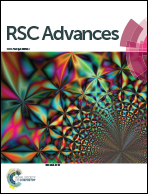High efficiency room temperature detection of NO2 gas based on ultrathin metal/graphene devices†
Abstract
Ultrathin metal (Au, Ag, Ti, Al, Pt and Pd) decorated chemical-vapor-deposition (CVD)-grown graphene sensors for NO2 detection were fabricated and their sensing performances were tested at room temperature (RT). All devices were found to exhibit far better response performances compared to the bare pristine graphene device. Ti and Al with a thickness of 1 nm were confirmed to be fully oxidized whereas other metals such as Au, Pt and Pd predominantly existed in the form of metals. The Pt decorated graphene sensors had the best sensitivity such as −5.8% upon 3 minutes of exposure to 0.2 ppm NO2 at RT with a recovery time of about 2 minutes. The Ti decorated graphene devices are believed to be potential sensors for NO2 detection due to their good sensitivity, response and recovery performance, and large dynamic concentration range. Both Pt and Ti decorated graphene devices showed relatively good selectivity and stability. The different electronic structures of the metals and the different synergic effects of the metals with graphene are responsible for the dramatic difference of the responses of these devices to NO2 gas. The current study provides solid experimental data for theoretical calculations, promoting the intensive exploration of the exact mechanism of response to NO2.


 Please wait while we load your content...
Please wait while we load your content...